Which are the most common bugs of Florida? Florida has at least 12,500 insect species. They all eat something, and whether humans call them “pests” depends on how they impact our lives.
Some of them eat the plants we consider important, and some of them bite, sting, or try to feed on us. Many insects are considered invasive species that arrived in Florida by accident or were intentionally introduced. Many of the invaders affect Florida residents and its environment in a negative way.
The following is a sampling of the 30 insect species most common to our state.

Palmetto Bug. Scientific name: Eurycotis floridana. This large cockroach grows to a length of 30–40 mm (1.2–1.6 in). It is found mostly outdoors, where it eats detritus and leaf-litter, but occasionally will sneak into houses.
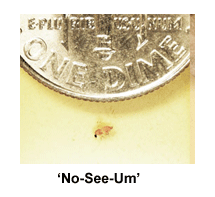
‘No-See-Um’. These are the biting midges of the genus Culicoides; 47 species of which are known to occur in Florida. They are so small that you can’t see them (hence the nickname ‘No-See-Um’). They are a nuisance to people outdoors who might spend time near shorelines or wetland areas when winds are calm. They leave small red welts where they bite.
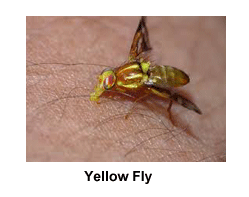
Yellow Fly. Scientific name: Diachlorus ferrugatus. Yellow flies are ferocious biters, with female flies needing a blood meal in order to develop their eggs after mating. Their peak season in Florida is April through June.
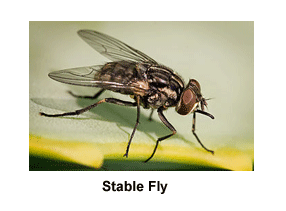
Stable Fly (Dog Fly). Scientific name: Stomoxys calcitrans. This biting fly originated in Asia, but now can be found worldwide. It mostly attacks dogs and cattle, but will also bite humans. In northwest Florida, stable flies will conglomerate in large numbers in seaweed washed-up on the shoreline and attack humans who venture too close. The small flies are affected by wind currents, and how the winds blow can determine how bad the biting will become. The flies can become so bad that it affects tourism.
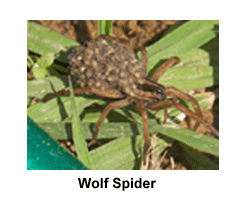
Carolina wolf spider. Scientific name: Hogna carolinensis. These large spiders can reach 25 mm (0.98 in) in size. Though they look ferocious, they shy away from humans. They are beneficial in that they consume insect pests for food. Females are noted for carrying their young on their back.
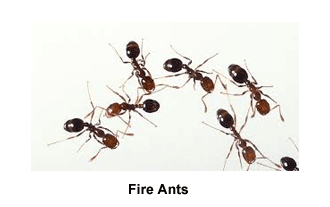
Red Fire Ant. Scientific name: Solenopsis invicta. The fire ant is native to South America, but has become a pest in the southern United States. Fire ant mounds can be found in back yards all over Florida. Fire ants give a painful sting that often leaves a swollen pustule on the skin.
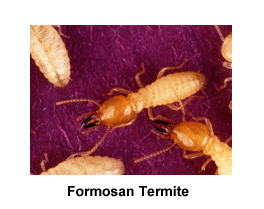
Formosan Subterranean Termite. Scientific name: Coptotermes formosanus. An invasive species from Asia, which arrived in Florida around 1980. It is often nicknamed the ‘super-termite’ because of its destructive habits. These termites can seriously damage a wooden structure in as little as 3 months.

Citrus Leafminer. Scientific name: Phyllocnistis citrella. This moth is an invasive species from Asia that first entered Florida in 1993. The moth’s larvae mines the leaves of citrus trees, severely impacting the Florida citrus industry.
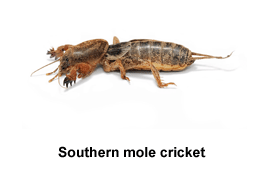
Southern Mole Cricket. Scientific name: Scapteriscus borellii. This insect is an invasive species from South America. It is fairly large—about 3–5 cm (1.2–2.0 in) long, and can be found in yards all over Florida where turf-grass is planted. Mole crickets burrow beneath the turf, feeding on the roots of the grass, causing damage to lawns.
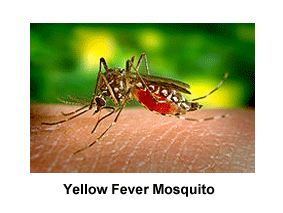
Yellow Fever Mosquito. Scientific name: Aedes aegypti. This mosquito is an invader from Africa which hitched a ride to the New World with the slave trade. It can spread the dengue fever, chikungunya, and yellow fever viruses, along with other diseases. Yellow fever became a scourge of the tropics and neotropics until effective mosquito control was instituted after about 1900. A yellow fever vaccine was developed by 1937.
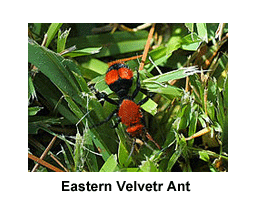
Eastern Velvet Ant. Scientific name: Dasymutilla occidentalis. This insect is actually a wingless species of wasp, attaining an approximate length of 0.75 in (1.9 cm). Females are capable of an extremely painful sting, hence the ant’s nick-name “cow killer”.
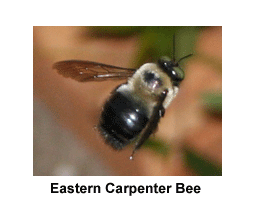
Eastern Carpenter Bee. Scientific name: Xylocopa virginica. It is often mistaken for a large bumblebee, as they are similar in size and appearance. They sometimes bore holes in wood dwellings, becoming minor pests. Only females can sting.

American Dog Tick. Scientific name: Dermacentor variabilis. This tick is common throughout the eastern and southern United States, to include Florida. It is one of the most well-known hard ticks and is a vector for Rocky Mountain spotted fever and tularemia.

Asian tiger mosquito. Scientific name: Aedes albopictus. This mosquito was first documented in Florida in 1986. It is a vector for several diseases, including equine encephalitis.
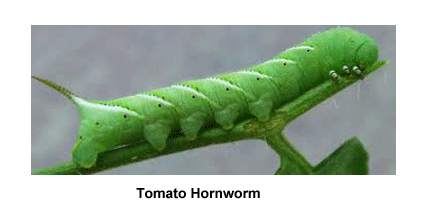
Tomato Hornworm. Scientific name: Manduca quinquemaculata. Tomato hornworms are large caterpillars that are the larvae of the Five-Spotted Moth. They are voracious eaters of tomatoes, potatoes, eggplant and peppers in back yard gardens and can quickly defoliate these plants.
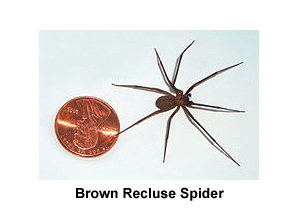
Brown Recluse Spider. Scientific name: Loxosceles reclusa. Only the extreme northwest portion of the Florida Panhandle lies within the natural range of this spider. The brown recluse possesses a powerful venom and can give a serious bite. Luckily, bites to humans from the species are uncommon.
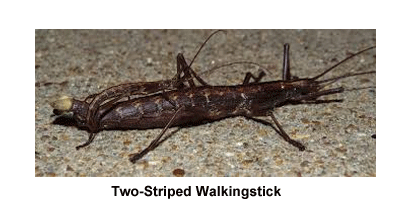
Two-Striped Walkingstick. Scientific name: Anisomorpha buprestoides. This is the most common stick insect in Florida, and can be found feeding on leaves of trees and shrubs.

Hieroglyphic Cicada. Scientific name: Anisomorpha buprestoides. This cicada prefers to eat the sap of oak trees. It is the first species to be heard in spring–its song starts with a sequence of progressively softer whiney bursts and ends with an even whine.
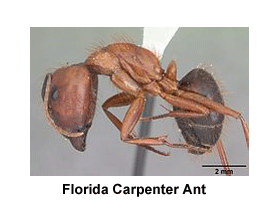
Florida Carpenter Ant. Scientific name: Camponotus floridanus. This ant is among the largest ants found in Florida. They do not sting, but can bite. They nest in soft rotting or pithy wood.

Southern Black Widow. Scientific name: Latrodectus mactans. This venomous spider is found throughout the southeastern United States. It likes to inhabit wood and rock piles, rodent burrows, and hollow tree stumps.

Thorn Bug. Scientific name: Umbonia crassicornis. The thorn bug is an occasional pest of ornamentals and fruit trees in southern Florida. The insect causes damage by piercing the plant tissue and sucking the sap and by making cuts in the plant for egg laying.

Lovebug. Scientific name: Plecia nearctica. Lovebugs swarm to mate in late spring and during the summer. Males and females will pair and remain stuck together during mating. Automobiles driving through a swarm of lovebugs will emerge covered with smashed bugs, and if not washed off soon, the insect residue can damage the paint on a car.

Florida Scorpionfly. Scientific name: Panorpa floridana. No living individuals of the Florida scorpionfly have ever been observed. Nothing is thus known about the insect’s habits and life history. It appears as if males of this species have a large stinger in their tail; however this is just a reproductive organ.
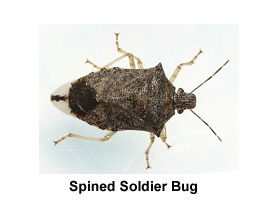
Spined Soldier Bug. Scientific name: Podisus maculiventris. This carnivorous insect is very beneficial to mankind, as it is a predator of around 90 insect species, to include several crop and garden pests.

Citrus Gall Midge. Scientific name: Prodiplosis longifila. This tiny midge lays its eggs in the buds of lime trees. The larvae when hatched feed on the flowers, damaging them, and interfering with fruit development.

Catalpa Worm. Scientific name: Ceratomia catalpae. This “worm” is actually the caterpillar of the Catalpa Sphinx Moth. These moths lay their eggs on the leaves of the southern catalpa tree, which hatch into the colorful larvae. The caterpillars are prized as bait by fishermen.
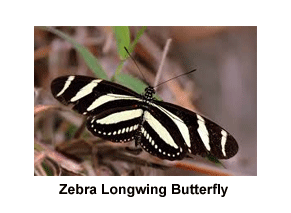
Zebra Longwing Butterfly. Scientific name: Heliconius charitonia. The zebra longwing butterfly is the state butterfly of Florida. It lays its eggs on the leaves of the passion fruit vine, and has a very colorful larval (caterpillar) stage.

Miami Blue Butterfly. Scientific name: Cyclargus thomasi bethunebakeri. A small butterfly that is native to coastal areas of southern Florida. Once very common throughout its range, it has become critically endangered because of habitat loss. It may be the rarest insect in the United States.
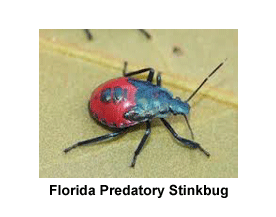
Florida Predatory Stinkbug. Scientific name: Euthyrhynchus floridanus. This carnivorous insect is very beneficial to mankind, because most of its prey consists of plant-damaging bugs, beetles, and caterpillars.

Gulf Coast Tick. Scientific name: Amblyomma maculatum. This tick is common throughout the southern United States, including all of Florida. It is of increasing concern because of its ability to transmit several pathogens of veterinary and medical importance.
References
Frank, J.H. & Thomas, M.C. (2015). Invasive Insects (Adventive Pest Insects) in Florida. Retrieved from http://edis.ifas.ufl.edu/in503
IFAS. (2015). Featured Creatures. Retrieved from
http://entnemdept.ufl.edu/creatures/main/search_common.htm
Need to know what bug or insect is gray and white hard shell heads on both ends and flat
Got a picture?
What kind of bug it’s small gray/white looks like a rock size of a Pencil eraser It had white egg on its back
I think it’s a moth. Look for Florida moth with shell
No.
Hello,
Just heard something about “ sealies”,
Insects swamp Florida keys. Bloodline
Is there anybody who can tell me more about this nasty creatures?
Thanks
R u from new jersey
it’s a bagworm lol, i used to find those in my home in florida all the time
how did you get rid of them, I have them in my house, have a small pet.
Was it 2 inches long. Did it crawl and hop?
The bug that’s in my house is a flat, soft-bodied, and a little lumpy shaped similar to a football, It has two cylindric protrusions, one on each both end for mobility. Also, it appears to have one antenna at the right end to help turn it. I watched the bug with a microscope to see the antenna. The protrusions were seen by naked eye. The ones I saw were about 1/4″ in length and smaller. I have searched the internet with no results.
My first guess Chas the “eyes Walter,”part of the click beetle family, but I’m sure you would have mentioned the “eyes.”
the picture you have for a ‘palmetto bug’ is actually an adult American cockroach, similar in appearance to the scientific name listed beneath it, however different. we still have both in Florida lol
Its a palmetto bug
You are both correct. It is a palmetto bug also known as the American cockroach. Pretty ugly either way!
My husband and I both have little tiny brown flying bugs in our cars. We are actually infested with them in our cars. I have pictures but I don’t know how to share them on this site. If someone would be kind enough to tell me how I can get my picture posted I would love to solicit some assistance. Thank you!
Hi Shannon, you can send your photos to dd2 [@] live [dot] nl and we’ll post them here.
Thank you so much. I just sent two pictures.
Thank you.
Added the photos here. Also have a possible ID. See the comment below. Let me know if that’s right.
I’m not too sure. I just sent two more closeups of better quality for detail. They are the size of a gnat. They do resemble the beatle.
We live in South Florida and have tons of Palm trees in our yard that we park under. I suspect it is related to the trees considering both of our vehicles have been invaded. These little critters are entering the cars in the little holes where the dash meets the hood.
I appreciate your help.
Thanks again!
How do I send pictures
You can upload them on imgur or another image upload website or mail them to dd2 [at] live [dot] nl.
I posted s pic of a bug that keeps crawling up my walls on the floor all over the house. Can you tell me what it is
I have the same problem. Did you find anything out about them?
Where r u? (Just in case it matters)
We have them too, did you find s solution?
It started under my feet and finger nails and I thought it was hair but the symptoms got worse it looks like a skinny worm but I don’t know how and where it came from
Banana peel under the seat?
How to get rid of no see ums
You should reduce or get rid of standing water in the yard. You can also use insecticides but due to their short lifespan you will have to re-apply regularly. Mesh screens will help keep them out of the home.
What bugs in Florida are black about an inch long and have yellow spots on it’s back?
Eastern lubber nymph.
There are some sprays to try. Cover all skin with clothing. Stay in breezy areas or an electric fan breeze on your face. There are some noseeum nets available online.
To reduce the attraction of “no-se-ums” use coconut oil on the outside and rum on the side I was told when we arrived in Florida.
Rum on the inside of what?
A bug bit me and it hurt like a bee and it was green can u find out what it is please it really hurt.
Was it metallic in color? We do have green metallic bees in south Florida.
Sweat bee
I am having a problem which I thought were ants and now I’m not sure. They are teeny teeny tiny bugs. I find them in my kitchen in my den in my office. Even on my computer screen and on me too they are such a nuisance. Raid doesn’t get rid of them. I live in Boca please please help. I will try to take a pic but they are quick some of them others kind of look like they are going in circles.
Liquid Terro. place a drop on a piece of foil or tear a section off from the box (the box provides this) and place in a corner where you see them coming in. You must endure them coming and going for a week or two. They feed on this Terro and will disappear for good after your patience. No patience-they’ll be around forever. Unlike other insects they have a queen but section off in groups to search for water mostly. Usually seen around the kitchen and bathrooms. You can spray around the foundation of the house up the sides and especially around windows but the spray will not get rid of them. From what I’ve read Raid and other insecticides may kill on contact but for all those ants killed in combat, so to speak, the queen gets to work and produces that much more to replace the dead. So, Terro drops are the only recourse you have.
I think these must be the bugs that I have just found in my keurig. I flushed the coffee maker with white vinegar, but that did not work…they are back.
they are so tiny, I can hardly see them but they seem to swim in clusters.
Mosquito larvae
Ghost ants and the absolute best bait for them is Maxforce quantum ..It can be purchased at a do it yourself pest control or off Amazon …I’m a pest control technician..believe me it works well…Don’t tell anyone I told you..Terro works but is very old school compared to quantum….
Does this come in child proof containers. Well animal proof, actually. We have them and they are devils. Ghost ants. I hate them.
I think i am having same issue; these bugs seem to be EVERYWHERE and just started the other and now seem to be all over, started once i opened my window but i took a photo and zoomed in, did the bugs u have look like this? http://tinypic.com/r/15rjyb9/9
I have the same tiny bugs in my home. They seem to be attracted to moist areas and enter the home through the smallest hole you can think of. What are they and how do I get rid of them. I just now a group of them in my carpet.
.
Oh and they are biege with little antennas I think. The antennas they are definitely biege
http://imgur.com/XKPhnt5
These bugs just showed up today. There appears to be a lot of them. Does anyone know what they are and how to get rid of them?
Thanks
Those are Love Bugs.
Those are Lubber grasshopper nymphs. You can read about them here: http://entnemdept.ufl.edu/creatures/orn/lubber.htm The only way to kill them is with NOLO BAIT (or to beat the crap out of them and then do it again to insure they are dead – they do NOT die easily). The NOLO BAIT has a shelf life of only 13 weeks so you want to buy it in about the middle of February (or maybe early February) and start putting it out (you can read about it on-line) because these pests start hatching in March.
LOL, best comments ever! “Beat the crap out of them and then do it again.” Boy are you right! The first year the lubbers showed up, I thought how pretty they were-at first. Then came the true invasion. Took a couple of seasons to get them more or less under control but you sure can’t close your eyes on this problem.
I need to know what this type of bug is? How do I post a pic?
Send a clear picture to dd2 [@] live [dot] nl.
Mention size. For instance 2 mm.
If possible with something for scale in it. Or something on the background. A remote control, a coin.
Mention where you encounter the bugs. For example; in your living room in Carlsbad, California.
Something is biting me in my car and home now it seems to be going to work and following me biting me and other.I saw something fly in the car during the day it looked gray.
We were sitting on Sunset Pier in Key West at sunset, a small black with orange wing highlights bit my forearm with a burning feeling. Got a small red raised bump with little oozing. What bug bit me?
Did it look kind of like a jet airplane shape?wings in V shape and small?If so it probably was a deer fly.They bite like crazy!
My girlfriend has gotten bite that are red tgat oozes then turns into little holes. Research tells dog tics and another florida tic that does this and leaves a hole. Legs chin, and inside nose, she don’t want to know, but I do?! Can attach picture if bites.
I need to know what kind of bug is this I can send the picture
You can upload a photo on imgur or another image upload website or mail it to dd2 [at] live [dot] nl.
I have an oval shaped small bug. Gray in color and looks like a piece of paper. Most of them are dead, but very few of them are alive and seem to glide across the floor. Hard to see the head. What are they?
I wish someone would answer this question! I love these little guys and I call ’em Pocket Pets. There is a little wormish guy inside & pulls itself along with its little front claws. They’ve never bitten me and I find them incredibly cute!
Silverfish by the sounds of it. They like the damp and are usually found in bathrooms. Not fish at all! Very common in the UK where I’m from. Not sure if they might have another name in the States.
I also thought of silverfish from the description. They have the same name in the states.
THEY ARE CALLED CASE MOTHS, THEY ARE COMMONLY FOUND IN BATHROOMS. THEY FEED ON CREATIN, WHICH IS FOUND IN HAIR, FINGERNAILS, AND DEAD SKIN.
Silverfish
When outside walking my dogs I was covered in tiny black bugs with stingers. They seem to be attracted to yellow because my shirt was covered in them but the rest of my clothes had nothing. This happened at the back of my home on a golf course, the lawn was just cut. Thank you for your help!
Hi, I have a quick question… my friend and I were deleting her backyard today and we’re pulling up broadleaf weed comet under the broadleaf weed there are these tiny orangish reddish bugs some with wings some without I’m trying to figure out what kind of bug that they are. We are located in Jacksonville Florida which is in Northeast Florida. It is a st. Augustine grass yard, well actually the parts that are left are st. Augustine grass the previous tenants ruined hair backyard by neglecting it. I have tried every single thing on Google, I have tried asking friends, etc… I am just looking to see if anyone knows what type of bugs that these may be. I am trying to capture one to get a picture but that is easier said than done. Small orangish reddish bug under broadleaf weed in the root system in dirt some with wings.
hello – i just sent you a picture of a white tick looking bug – they are on my lawn in small numbers but also on young tree and it looks like they are eating the leaves…. at least something is eat the leaves but this white bug is the only thing that is visible on the tree’s leaves. thank you in advance. anthony
Hi Anthony, I posted your photo and description of the white tick looking bug.
Hello!
My grandmother’s house seems to be infested with this wasp like bug and we are not sure what it is can you help us figure it out?
Won’t those bugs bother u in Florida I’m afraid.to go out.there How.dose.people walk and.do thing with those spiders
how do i get rid of no see-ums?
Sarasota Saturday Market. Visit the booth where Lynn, the bug lady works. She sells all natural sprays that reprell no seeums, mosqitoes, and fleas from humans and pets.
I just purchased a couch and now I have seen about 4 of these little things crawling on it. Anyone know what this is?
http://imgur.com/0ekpN5Q
Bed bugs?
Not sure what bug this is, they seem to invade the bathroom areas & are kinda crunchy to the touch when you press them against the countertop. They do not seem to fly. We live in Tampa, Fla. Please help if you can with ID & a way to get rid of them. Thanks in advance for your help ! I will send an email pic now
What is the little black flying bug mating on Marco Island right now. Can’t open our doors. How long will this invasion last?
Any idea what kind of critter this is. Slightly bigger than s pin head. It has a round body. Not flat like a bed bug or tick. Maybe segmented. I live in Tampa Florida. Any help is appreciated. Thanks.
Email uniqueantiquesjax@gmail.com for pictures. It doesn’t look like I can post pictures on Bugoff.com
I have the same kind bigger than pin head round and black
Have tiny ant looking insects on kitchen counter. They are smaller than the head of a pin and they move around pretty fast for their size.
Please Advise
I need to know what these worms are my dogs keep drinking the water and they hack and hack all day long any ideas they seem to have 2 tails and feed on the algae in the bucket
Central Florida, Hernando, living room floor. 1 inch long, about as thick as a wooden match stick, black caterpillar type slow moving. I’ll get a picture next time.
I found a small brown oval bug on my bed sheet i went to look foe something to kill it and then it disappeared and im not sure what it was. Any advice
I live in New Port Richey FL. I keep seeing these black bugs, about an inch long with long legs and yellow spots. I have a child and have heard of kissing bugs, was wondering if these are those?
By the apalachacola river there were thousands of white larva with wings flying over us I mean thousands. It looked like it had snowed. What are they?
I have a big bug flying with big wings large body six legs found in a pile of dirt had brought in . never seen anything like it live in wesley chapel, florida i am a native floridian and never seen one of these
cant send pic have any idea where I can look up more pictures
Hi in my house there are tiny like microscopic and they are red and have little tiny white spikes on there back
We have bugs that are about 1/4 in. grown, little ones about size of a speck, they are
dark brown to black and look similar to a roach, move really fast , mostly found in pantry and countertops in kitchen. We have tried roach bait and spray, doesn’t seem
to phase them. They come out mostly at nite and early morning, found s feral in a
box of opened dry chicken bullion individually packaged. Live close to Tallahassee,
Fl.
Hi did you ever find out what they are or how to get rid of them, thanks
Can someone identify this bug? They seem to be all over our screened in area.
Large insect (?) likes to get inside my small fan when it’s on and seems to like to play in it?? Very strange and I’ve never gotten a good look at it. Thought it could be a large roach?? But, I’m really afraid to sleep in my bedroom. What do you think??
This will sound strange but it’s for real. We have a rather large insect that I first saw inside a small fan (while the fan was running) and every night, after dark, until twilight in the morning it’s there. I cannot seem to get close to it – it disappears. I’m afraid to sleep in that room now because I don’t know what it is and cannot get close enough to get a picture. In and around the small fan is the only place I’ve seen it. What do you think it is? I’ve googled insects of Florida, but no answers.
How do I email pictures to find out what bug this is.
What is the black winged insects that seem to prefer the beach areas? They appear to be swarming now and die if the land on hot car hood. These insects were a nuisance on the Pass-A-Grill beach.
We have flying bugs that look kind of like a mosquito but they’re larger than a quarter but smaller than a half dollar coin. They’re just now starting to mate because we see many that are stuck together from tail to tail. They resemble the Scorpion Flies but I’m not too sure just what they are.
Anyone have any ideas on what they might be and how to get them to stay out of the house at night? Leaving porch lights off helps a lot, I’ve found this with most nocturnal insects.
Thanks for these posts and your time,
David
In Ft. Myers, FL, I had an excellent pest control, husband & wife, Wes & Patty Jones of Cape Coral, owners of EXCELLENT PEST CONTROL! One day when they showed up to treat my house, they found a few ants on my window seat in guest bedroom. Patty put down a dime size drop of a product named InTice made by Rockwell Labs. After they, put the drop down, I went to check on the activity, there was HUNDREDS. They went to check InTice , the dime size application WAS TOTALLY GONE, and haven’t seen an ant since.
I was swimming in my pool, in Florida. SO, beside the pool, I found this bright red and blue water creature. It was pretty big, it had no legs or face, it was just ridges, kinda like spikes. However, the spikes weren’t hard, they were mushy, it felt like the bottom of my tongue. When I touched it, it moved like a snail.
I need help with bug identification
I need to know about a bug with many legs, can fly, and has a leg or something that shakes
How do you leave off the spiny bodied spider? And your eurycotis floridanis picture was really an American cockroach, another of which I have no idea you left out. Unfortunately.
This insect looks like a tiny brown caterpillar. If you touch it, it will curl up. I am finding them in my house. I find them one at a time, but can see at least 4 per day. They are being seen on walls, floors, on my carpet. Can you tell me what they are ?
I hav pest control once a month to spray our yard and outside of home but the past few days I’ve seen several 3 sectioned ant like bugs in my master bedroom and the outer 2 sections are dark but the middle section is an orange/red color. No visible wings. Most are dead but every night I pick up the dead ones and kill the live ones. They seem to congregate in my bedroom right around the outside of my closet! Any idea what they are and why so many in one particular area? Thank you in advance for any help you can share with me!
Um, there’s this beetle or something in my bathroom, it’s dark and grey, and whenever i touch it, it makes a noise like it’s making tiny short weird screams or something. What is it?
What kind of bug is this
This is the third time I’ve seen this bug at my house, twice in the pool and once in the house I can not figure out what it is. It is long and blackish and appears to have pincers on the front and black and maybe wings in the middle of its body.
what flying insect has black wings with small white dots–an orange tip on the end of its body—rather large insect–3/4 to one inch in length
What about Fleas? That’s common everywhere!
I need to know what bugs are extremely small and bright yellow
Hey, I got bit by something round and hard. I brushed it off. But, apparently it left a hard, red raised bump, that is slightly painful to touch. Is there any Florida insect that can leave a bite like that?
I have a photo.
How do I send it to you ?
dude on time i found a huge catrpiller that looked just like the black one in the picture. LOL
it is about an inch long, has 8 legs and moves with a bullet speed
found it on the window sill in South Pasadena, Fl
What are the plain black bugs swarming central Florida right now? They remind me of love bugs, that’s how bad they are. I’ve never seen them before but I’m living at a new house so I don’t know if that has anything to do with it